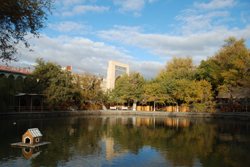Miniature Artists in Bukhara
21 October, 2008, 03:30 am in "Uzbekistan"
At the Nadir Divanbegi Medressa I talked to a woman who painted miniatures. Her husband and children did as well. She showed me the different types of skatochki (palek boxes) ranging from the cheap ones painted on plastic boxes from China, to the fake ones I'd seen with printed pictures lacquered on decoupage style to the real lacquer boxes with paintings done by hand.
Across the way at the Kukeldash Medressa, I talked to another miniature artist, Alisdair, who had a workshop he shared with his brother. He had a wide variety of miniatures as well as some designs painted on ceramics. He studied traditional Uzbek art at the University in Bukhara which has a national art program where students learn not only miniature painting and ornamentation but also the arts used in designing Uzbek homes-- ceiling painting, ganch, wood carving.
He also said that the best paper was old silk paper which the artists get from old books, sometimes cleaning ink of the pages (I think since I've seen some miniatures with traces of writing.) It is so wild to think that they destroy these books that are so old. I asked if they didn't make new silk paper somewhere. He said the knowledge had been lost, however, in Samarkand they had gotten close. Even though there are lots of souvenir seller here, I find it more tolerable than Khiva. It seems like there are higher quality items and many of the shops are owned by artists who create at least some of the items they sell.
At the Bukhara Artists Development Center, I met Jihangir, a miniature artist specializing in the Bukhara style. I asked him what the difference was between the Bukhara style and other styles. He said the subjects were more abstract and spiritual. For example in Turkey the miniatures were based on historic events and in PersiaŚliterature. In Bukhara the subjects were based on Sufism and the inner world of the individual. As an example, he showed me a miniature he was working on of a beautiful white horse led by a weak person crumpled on the ground. The horse was the body and the crumpled person was the soul. The meaning being that the person spent too much energy taking care of the body and ignored the soul which was weak and sleeping. Jihangir said it was for his next exhibition which would be in Istanbul. When I told him I used to live there, we started talking about it. He had also taken ebru classes from Hikmet Baracugil whom he had met at an exhibition in the UK (I think). He was interested in reviving the art of ebru in Bukhara which, he said, was where it originated but is now lost and there are no practitioners. They are starting a program to do it at the crafts center.
Another work he showed me was his original compositions for a book of Navoi's poetry. They were displayed as a series on the wall. As I was looking at them, a woman came in looking for a miniature of a yurt. I was surprised when he dug into a drawer and produced one because I don't think I've seen many miniatures of yurts.
Comments
- Comments
Powered by My Blog 1.69. Copyright 2003-2006 FuzzyMonkey.net.
Created by the scripting wizards at FuzzyMonkey.net..
(Code modified by Rowshan Dowlatabadi)
Created by the scripting wizards at FuzzyMonkey.net..
(Code modified by Rowshan Dowlatabadi)


